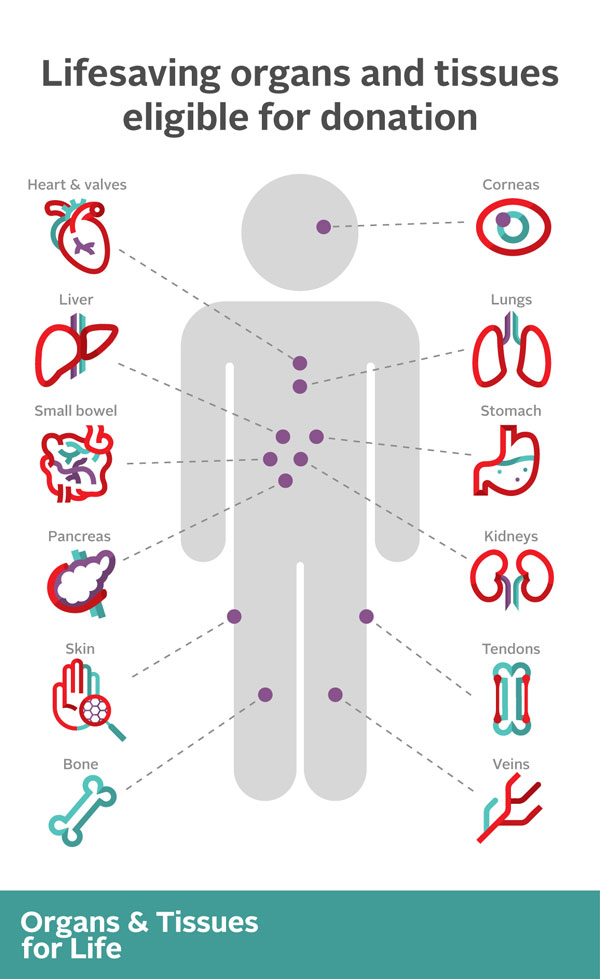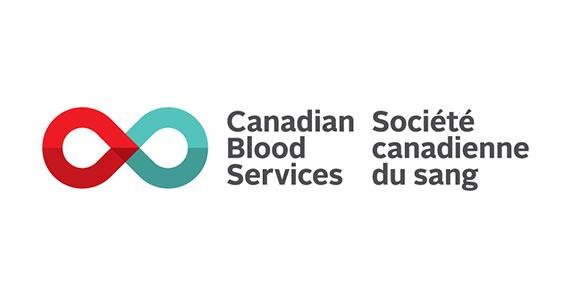Lifesaving organs and tissues that can be donated
Lifesaving organs and tissues that can be donated
Region
Canada
Grade Level
6-12
Media Type
Poster
Infographic
Miscellaneous
Science
Biology
Age Level
11-18
Language
French
English
Description
A downloadable graphic poster to help visualize the organs and tissues that can be donated. Hang up in your classroom or share with your class or on social media.
Quick fact: Deceased donation is a rare occurrence. For someone to become a deceased organ donor, they haves to die under very specific circumstances. The opportunities for deceased organ donation remain limited as only about 1% of deaths occur in such a way to allow for donation.

More information about each of the organs and tissues that can be donated:
Organs that can be donated
- Heart – Our heart pumps blood through our bodies. The heart is the body’s hardest working muscle, pumping blood throughout the body. A transplant is needed when the heart gets “tired” or has been weakened by cardiovascular diseases, infections, or birth defects. A heart transplant can be performed when a person does not respond to medicines or machines and is otherwise healthy.
- Kidneys – Our two kidneys help to clean our bodies of waste. They also make urine. Kidneys remove waste from the body by creating urine. Our total blood supply is filtered by the kidneys about once every five minutes. Kidneys regulate blood pressure, blood volume, and the chemical (electrolyte) composition of the blood. A kidney transplant is used to treat kidney failure, a condition in which the kidneys function only at a fraction of normal capacity. People with this condition require either artificial blood filtering (dialysis) or a transplant to stay alive. Reasons for poor kidney function include diabetes, high blood pressure, damage caused by drug overdose or intoxications, or a number of diseases that can be inherited. A donated kidney can take over the work of the two kidneys that failed, so the recipient no longer needs dialysis.
- Liver – Our liver helps to break down the food we eat. The liver is the largest organ in the body and has the capability to regenerate itself. The liver helps fight infection and cleans the blood; filters medications and toxins; metabolizes carbohydrates, fats, and proteins; helps in digesting food; and stores energy. Liver failure can be caused by viral infections, genetic disorders, or alcoholism. These liver diseases lead to cirrhosis which creates scar tissue that blocks the flow of blood and impedes the liver’s functions. Immediate damage to the liver can be caused by drug overdose. A liver from an adult donor can often be split and transplanted into two people.
- Lungs – Our two lungs help us to breathe. The lungs bring oxygen into the body and remove carbon dioxide from the body. A person is able to live with only 30 percent lung capacity although this significantly impacts on their quality of life. Reasons for transplant include hereditary issues, smoking, and environmental pollution. Single or double lung organ transplants are possible.
- Pancreas – Our pancreas helps our bodies to digest food. The pancreas is part of the digestive system that produces insulin, a hormone that transforms sugar into fuel for the body. The pancreas also produces enzymes that break down fat, protein, and carbohydrates during digestion. A person with a poorly functioning pancreas has a surplus of sugar in the blood. Excess sugar in the blood can lead to kidney failure, heart disease, stroke, or even death.
- Intestines/Bowels – Our intestine turns food and liquid into fuel for our bodies. The intestines are part of the digestive system helping the body to absorb nutrients and remove waste products. Conditions that create problems for the small intestine include short bowel syndrome, tumors, Crohn’s Disease and other inflammatory bowel diseases, and congenital heart defects. Small bowels are most commonly transplanted in children.
Tissues that can be donated
- Heart valves – As the heart muscle contracts and relaxes, the valves open and shut, letting blood flow into different parts of the heart. Transplants may be needed because of infection, age-related changes, or malformed valves. Some children are born with malformed valves. Heart valves transplanted into a young patient’s body will grow with that person.
- Veins and arteries – The “highway” system of the body is made up of veins and arteries. These tissues carry the blood around the body. Veins carry blood filled with carbon dioxide and wastes. Arteries carry blood filled with oxygen. Donated veins/arteries are most commonly used for heart bypass surgery or diabetics who are threatened with losing a limb. They are also used to connect a transplanted organ if the recipient’s vessels are damaged.
- Bone – Bone is the most commonly transplanted part of the body. It provides stability and mobility to the body but also acts as a “mineral bank” for calcium, magnesium, and phosphorus storage. Bone tissue is used to restore mobility/function. o Other uses include replacements for bone resections related to tumors and fractures; in traumatic athletic injuries; in reconstruction of the bladder; tendon repairs (knee surgeries); dental surgeries.
- Corneas – The cornea is the clear covering of the eye and is the only living tissue in the human body that does not contain blood vessels. Patients who need a transplant are those who have a disease, scar, or active infection involving the cornea.
- Skin – Skin is the body’s first line of defense against microbes. Skin, removed from the donor’s back or legs in paper-thin, nearly transparent layers, is used as a temporary cover while the recipient’s skin heals. Skin donation may be required because of burns, cancer lesions, diabetic foot ulcers, or genetic blistering diseases.
- Connective Tissue – Connective tissue is the cellular “glue” of the body. It gives the tissues their shape and keeps them strong. Connective tissues support, bind, and anchor tissues to one another and interconnect organs. Tendons and ligaments are examples of connective tissue. Connective tissue transplant can be done as a result of trauma or cancer.
Content Links
The Human Body - What can be donated
Video: Learning to Save Lives (Organs & Tissues)
Deceased organ and tissue donation
What is living kidney donation?
Infographic: Organ transplants in Canada, 2020
Infographic: Trends in end-stage kidney disease in Canada,* 2019


